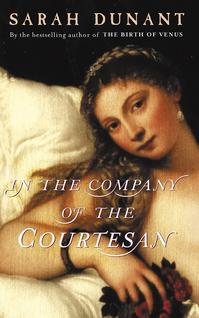Our book group choice for April 2006 is In the Company of the Courtesan by Sarah Dunant. Escaping the sack of Rome in 1527, with their stomachs churning on the jewels they have swallowed, the courtesan Fiammetta and her dwarf companion, Bucino, head for Venice, the shimmering city born out of water to become a miracle of east-west trade: rich and rancid, pious and profitable, beautiful and squalid.
In the Company of the Courtesan is a historical novel set in 16th-century Venice. The story is told from the perspective of Bucino Teodoldi, a dwarf who is the loyal companion, business partner, and pimp of Fiammetta Bianchini, a beautiful courtesan.
The novel begins with Bucino and Fiammetta fleeing the sack of Rome in 1527. They have swallowed jewels to protect them from the invading soldiers, and they are determined to make their way to Venice, where they hope to start a new life.
Venice is a city of contrasts, where wealth and poverty, beauty and squalor, piety and profit, all coexist. Bucino and Fiammetta quickly learn that they will need to be cunning and resourceful if they are to survive in this harsh environment.
Fiammetta is a talented courtesan, and she soon attracts the attention of the city’s most powerful men. Bucino is her manager and protector, and he is always there to ensure that she is safe and well-compensated.
However, their relationship is not without its challenges. Bucino is fiercely protective of Fiammetta, and he often clashes with her lovers. He also struggles with his own insecurities, as he is aware of his physical limitations.
Despite the challenges, Bucino and Fiammetta’s friendship is strong. They are each other’s confidantes, and they rely on each other for support. Together, they navigate the dangerous waters of Venetian society, and they eventually find a place where they belong.
In the Company of the Courtesan is a story of love, loss, friendship, and survival. It is also a vivid portrait of one of the world’s most fascinating cities at a time of great upheaval.
Here are some additional details about the novel:
- The novel is based on the real-life courtesan Veronica Franco, who was a prominent figure in Venetian society in the 16th century.
- The novel explores the themes of beauty, love, loss, friendship, loyalty, and betrayal.
- The novel is set against the backdrop of the sack of Rome in 1527, one of the most destructive events in European history.
- The novel has been praised for its historical accuracy, its vivid depiction of Venice, and its complex and well-developed characters.
Discussion Questions
- In what way does In the Company of the Courtesan seem historically accurate to you? What details about Renaissance Italy do you think came from the author’s imagination, and what aspects of it do you think are based on her historical research of the period?
- Do you think a character like Fiammetta could exist in today’s world? What, if anything, is modern about her?
- What did you think of Fiammetta’s relationship with her mother, and of her mother’s influence on her life?
- In the Company of the Courtesan is told from Bucino’s perspective. Why do you think the author wrote it this way, rather than from Fiammetta’s point of view? What are the benefits of hearing the story and seeing Venice from Bucino’s standpoint? What are the limitations?
- We tend to think of Fiammetta’s profession as one that is very hard on women, one that doesn’t make for a happy life. On the whole, do you consider Fiammetta to be content or unhappy?
- Did you find La Draga to be a likeable character? Did your view of her change as your reading progressed?
- Is it accurate to describe Courtesan as a novel of “rebirth”? What are some other themes of this novel?
- Do you think Fiammetta was truly in love with Foscari? If you don’t, how would you define their relationship? Was Bucino’s anger at this relationship justified?
- What does sixteenth-century Venetian society have in common with our society today?
- Why do Bucino and Fiammetta make such a good team? What makes them successful?
- The picture on the cover of Courtesan is a detail from a painting by Tiziano Vecellio (Titian). When you were reading the novel, did you form an image of Fiammetta that was based on this cover image, or did you make up your own image of her? If your own, can you describe it?
- What predictions would you make about little Fiammetta’s future life? Do you think she’ll have the same profession as her namesake?

